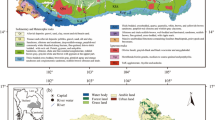Abstract
Uranium mining may pose a large threat for freshwater ecosystems, caused by elevated concentrations of metals/radionuclides in drainage water. Important pollutants of such waters are uranium (U) and radium (Ra), because of their impact due to both radio- as well as chemo-toxicity. Despite the comprehensive knowledge about specific element speciation as well as fixation processes, less is known about the retention of U and Ra at a higher level of complexity (within allochthonous ecosystems as predominant for low order streams). Consequently, we investigated the distribution and retention potential of allochthonous ecosystems regarding U and Ra as well as changing U/Ra ratios. We found U predominantly transported over long distances, whereas Ra mainly precipitates immediately after reaching the surface, i.e. in the spring area. Although high U accumulation in organic rich sediments is found, still high transport rates are detected. Low overall fixation of U within the allochthonously dominated wetland results in an U transport over long distances. Consequently, large areas are affected by U mining activities and its post-mining impact, with U being more relevant compared to Ra.

Similar content being viewed by others
References
Benes P, Sebesta F, Sedlacek J, Obdrzalek M, Sandrik R (1983) Particulate forms of radium and barium in uranium-mine waste-waters and receiving river waters. Water Res 17:619–624
Bleise A, Danesi PR, Burkart W (2003) Properties, use and health effects of depleted uranium (DU): a general overview. J Environ Radioact 64:93–112
Brookins DG (1988) Eh-ph diagrams for geochemistry. Springer, Berlin-Heidelberg
DIN-EN-1484 (1997) Anleitung zur Bestimmung des gesamten organischen Kohlenstoffs (TOC) und des gelösten organischen Kohlenstoffs. Deutsches Institut für Normung, Berlin
DIN-EN-13805 (2002) Lebensmittel—Bestimmung von Elementspuren—Druckaufschluss. Deutsches Institut für Normung, Berlin
DIN-EN-ISO-17294-2 (2004) Wasserbeschaffenheit—Anwendung der induktiv gekoppelten Plasma-Massenspektrometrie (ICP-MS) - Teil 2: Bestimmung von 62 Elementen (ISO 17294-2:2003), Deutsche Fassung EN ISO 17294-2:2004. Deutsches Institut für Normung, Berlin
DIN-ISO-10694 (1995) Soil quality—Determination of organic and total carbon after dry combustion (elementary analysis) (ISO 10694:1995). Deutsches Institut für Normung, Berlin
Franke K, Rossler D, Gottschalch U, Kupsch H (2000) Mobilization and retardation of uranium DOC species at three mine piles in Schlema/Alberoda, Saxony, Germany. Isotopes Environ Health Stud 36:223–239
Håkanson L, Jansson M (1983) Principles of lake sedimentology. Springer, Berlin; Heidelberg
Iwasaki T, Fujiwara D, Hirakawa N (1998) Time-integrated radiotoxicity index for study of transmutation of long-lived nuclides. Prog Nucl Energy 32:449–456
Jakubick AT, Kahnt R (2002) Remediation oriented use of conceptual site models at WISMUT GmbH: Rehabilitation of the Trünzig tailings management area. In: Merkel B, Planer-Friedrich B, Wolkersdorfer C (eds) Uranium in the aquatic environment. Springer, Berlin
Landa ER (2003) Mobilization of radionuclides from uranium mill tailings and related waste materials in anaerobic environments. J Radioanal Nucl Chem 255:559–563
Langmuir D, Riese AC (1985) The thermodynamic properties of radium. Geochim Cosmochim Acta 49:1593–1601
Lauria DC, Almeida RMR, Sracek O (2004) Behavior of radium, thorium and uranium in groundwater near the Buena Lagoon in the Coastal Zone of the State of Rio de Janeiro, Brazil. Environ Geol 47:11–19
McCready RGL, Bland CJ, Gonzales DE (1980) Preliminary studies on the chemical, physical, and biological stability of Ba/RaSO4 precipitates. Hydrometallurgy 5:109–116
Meinrath G, Volke P, Helling C, Dudel EG, Merkel BJ (1999) Determination and interpretation of environmental water samples contaminated by uranium mining activities. Fresenium J Anal Chem 364:191–202
Michel R, Feuerborn J, Knoechel A, Miller F, Ritzel S, Treutler HC, Von Tuempling W, Wanke C (2005) Radionuclides in the Mulde River system after the August-2002 flood. Acta Hydrochim Hydrobiol 33:492–506
Mkandawire M, Taubert B, Dudel EG (2005) Resource manipulation in uranium and arsenic attenuation by Lemna gibba L. (duckweed) in tailing water of a former uranium mine. Water Air Soil Pollut 166:83–101
Robbins JA, Edgington DN, Kemp ALW (1978) Comparative 210Pb, 137Cs, and pollen geochronologies of sediments from Lakes Ontario and Erie. Quatern Res 10:256–278
Ross JH, Dudel EG (2008) Uranium loads and accumulation in a mine water contaminated wetland. In: Rapantova N, Hrkal Z (eds) Mine water and the environment. Technical University of Ostrava, Ostrava
Schaller J, Weiske A, Mkandawire M, Dudel EG (2008) Enrichment of uranium in particulate matter during litter decomposition affected by Gammarus pulex l. Environ Sci Technol 42:8721–8726
Schaller J, Weiske A, Mkandawire M, Dudel EG (2010) Invertebrates control metals and arsenic sequestration as ecosystem engineers. Chemosphere 79:169–173
Schaller J, Brackhage C, Mkandawire M, Dudel G (2011a) Metal/metalloid accumulation/remobilization during aquatic litter decomposition in freshwater: a review. Sci Total Environ 409:4891–4898
Schaller J, Weiske A, Dudel EG (2011b) Effects of gamma-sterilization on DOC, uranium and arsenic remobilization from organic and microbial rich stream sediments. Sci Total Environ 409:3211–3214
Schott A, Brand RA, Kaiser J, Schmidt D (2005) Depleted Uranium (DU)—chemo- and radiotoxicity. In: Merkel BJ, Hasche-Berger A (eds) Uranium in the environment. Springer, Berlin
Sridhar KR, Barlocher F, Wennrich R, Krauss GJ, Krauss G (2008) Fungal biomass and diversity in sediments and on leaf litter in heavy metal contaminated waters of Central Germany. Fundam Appl Limnol 171:63–74
Thiry Y, Van Hees M (2008) Evolution of pH, organic matter and (226)radium/calcium partitioning in U-mining debris following revegetation with pine trees. Sci Total Environ 393:111–117
World Health Organisation (WHO) (2004) WHO Guidelines for drinking-water quality. WHO, Geneva
Acknowledgments
The authors are grateful to Mrs. K. Klinzmann, Ms. Dominique Hille and Mr. Tom Gründer (all Institute of General Ecology, TU Dresden).
Author information
Authors and Affiliations
Corresponding author
Electronic supplementary material
Below is the link to the electronic supplementary material.
Rights and permissions
About this article
Cite this article
Nassour, M., Weiske, A., Schaller, J. et al. Distribution and Relationship of Uranium and Radium Along an Allochthonously Dominated Wetland Gradient. Arch Environ Contam Toxicol 68, 317–322 (2015). https://doi.org/10.1007/s00244-014-0117-4
Received:
Accepted:
Published:
Issue Date:
DOI: https://doi.org/10.1007/s00244-014-0117-4




